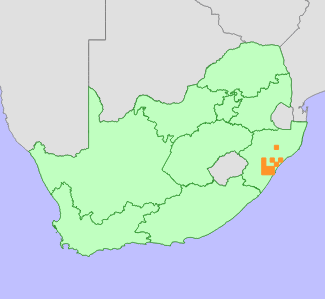|
Scientific Name | Aloe kraussii Baker |
Higher Classification | Monocotyledons |
Family | ASPHODELACEAE |
National Status |
Status and Criteria | Endangered B2ab(ii,iii,iv,v) |
Assessment Date | 2019/01/25 |
Assessor(s) | H. Mtshali |
Justification | Aloe kraussii is a widespread species (Extent of Occurrence 11 062km²), but has become rare due to extensive habitat loss and degradation. Between five and 10 severely fragmented subpopulations remain on isolated grassland fragments, and therefore this species' Area of Occupancy is estimated to be 20-100 km². It continues to decline due to ongoing habitat loss and degradation. |
Distribution |
Endemism | South African endemic |
Provincial distribution | KwaZulu-Natal |
Range | This species is endemic to KwaZulu-Natal province, South Africa, where it occurs between Richmond and Greytown, and eastwards to Durban. |
Habitat and Ecology |
Major system | Terrestrial |
Major habitats | KwaZulu-Natal Sandstone Sourveld, Midlands Mistbelt Grassland, KwaZulu-Natal Highland Thornveld, Moist Coast Hinterland Grassland, Dry Coast Hinterland Grassland |
Description | It occurs on grassy slopes. |
Threats |
| This species has become rare due to habitat loss to timber plantations and sugarcane fields. In other areas where it occurs the habitat is degraded by invasive alien species, including eucalypts, black and silver wattles. Around Pietermaritzburg and Durban, many subpopulations known through historical records are now locally extinct due to habitat loss to urban expansion, and loss continues. |
Population |
This species is unlikely to survive in the long term unless efforts are made to preserve habitat where it is found (Craib 2005). Historical records are from a wide area stretching from Zululand District to Richmond. These records however have imprecise locality description, and many have never been relocated. According to Craib (2005) the plants are now extinct in a number of areas recorded by Reynolds (1969).
|
Population trend | Decreasing |
Notes |
| Reynolds (1969) considered Aloe krausii to be allied to A. ecklonis. Glen and Hardy (2000) reduced this species to synonymy under A. ecklonis but gave no reasons to their decision (Craib 2005), and therefore the species has been reinstated. A lack of recent records for this species may be due to historical taxonomic confusion. |
Assessment History |
Taxon assessed |
Status and Criteria |
Citation/Red List version | | Aloe kraussii Baker | Not Threatened | Hilton-Taylor (1996) | |
Bibliography |
Craib, C. 2005. Grass Aloes in the South African Veld. Umdaus Press, Hatfield.
Glen, H.F. and Hardy, D.S. 2000. Aloaceae (First part): Aloe. In: G. Germishuizen (ed). Flora of Southern Africa 5 Part 1, Fascicle 1:1-159. National Botanical Institute, Pretoria.
Hilton-Taylor, C. 1996. Red Data List of southern African plants. 1. Corrections and additions. Bothalia 26(2):177-182.
Reynolds, G.W. 1969. The Aloes of South Africa. A.A. Balkema, Cape Town.
Smith, G.F., Steyn, E.M.A., Victor, J.E., Crouch, N.R., Golding, J.S. and Hilton-Taylor, C. 2000. Aloaceae: The conservation status of Aloe in South Africa: an updated synopsis. Bothalia 30(2):206-211.
Van Wyk, B.-E. and Smith, G. 2003. Guide to aloes of South Africa. (2nd ed.). Briza Publications, Pretoria.
|
Citation |
| Mtshali, H. 2019. Aloe kraussii Baker. National Assessment: Red List of South African Plants version 2024.1. Accessed on 2025/12/23 |
 Comment on this assessment
Comment on this assessment

